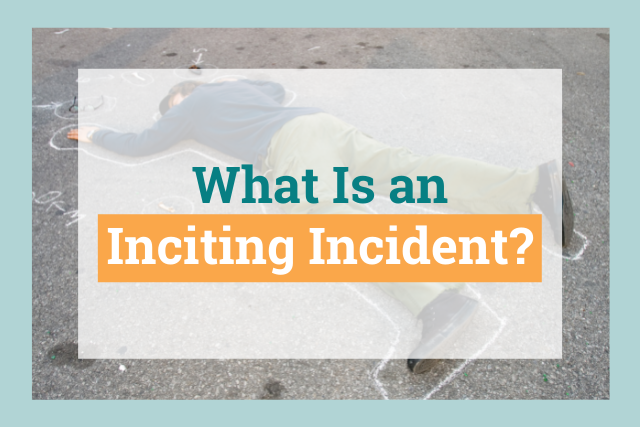
What do the following three scenarios have in common?
- A girl meets a boy
- A victim gets murdered
- A voice says: “Your mission, if you choose to accept it…”
All three of these scenarios are classic examples of inciting incidents.
The inciting incident is one of the most important plot points in any story. A great inciting incident should pave the way for everything else to follow.
So what exactly is the inciting incident, and how do you write an effective one?
Read on to learn the definition of an inciting incident, what inciting incident examples look like in popular books and movies, and how to craft one for your own story.
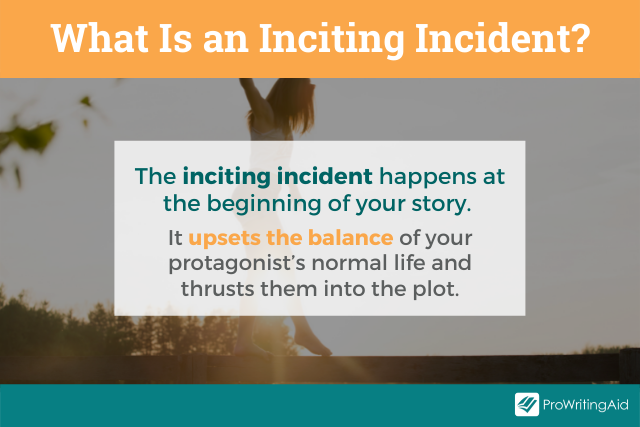
What Is the Definition of an Inciting Incident?
The inciting incident is the event at the beginning of every story that upsets the balance of your protagonist’s normal life and thrusts him or her into the story.
Without the inciting incident, the rest of the plot wouldn’t happen at all.
A good story should be a chain of cause and effect, with each event causing the next event. The inciting incident is the first event in the chain—the event that prompts the main character to take action and sets off all the plot points to follow.
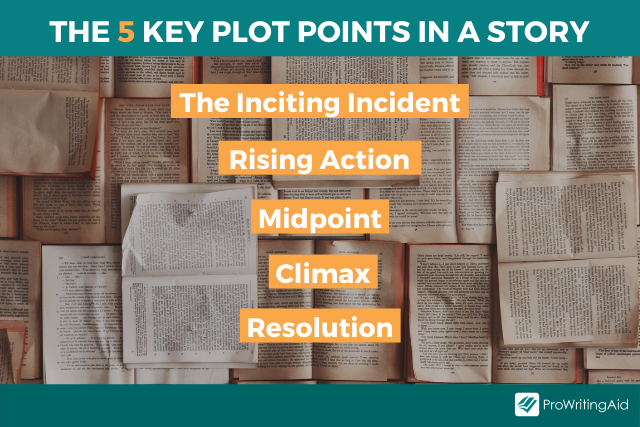
You might hear inciting incidents referred to by different names in different story structure frameworks.
It’s synonymous with the “call to adventure” in Joseph Campbell’s hero’s journey and the “catalyst” in Dan Snyder’s Save the Cat beat sheet.
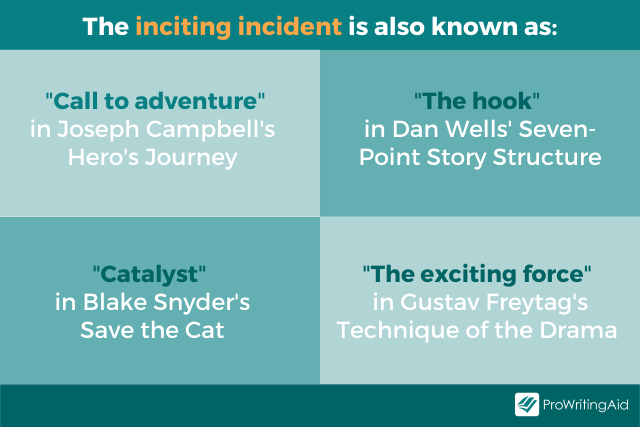
What Are the Characteristics of Inciting Incidents?
All inciting incidents must have the following four characteristics:
- It happens early in the story, ideally before the 10% mark
- It disrupts the status quo and upsets the balance of the protagonist’s normal life
- It’s out of the protagonist’s control. The inciting incident can be a letter the protagonist receives in the mail, but it shouldn’t be a letter that the protagonist sends to someone else
- It forces the protagonist to make a difficult choice that will change their life, such as whether to go on a dangerous quest or to stay in the safety of their home
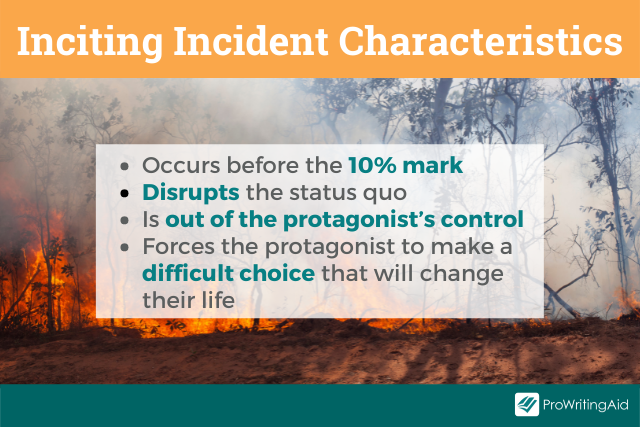
What Are Some Famous Inciting Incident Examples?
Similar stories often require similar inciting incidents. We’ll look at examples from well-known books and movies of inciting incidents that do the following five things:
- Invite the protagonist to go on an adventure
- Introduce the protagonist to another person
- Create a mystery that the protagonist needs to solve
- Hit the protagonist where it hurts most
- Challenge the protagonist’s worldview
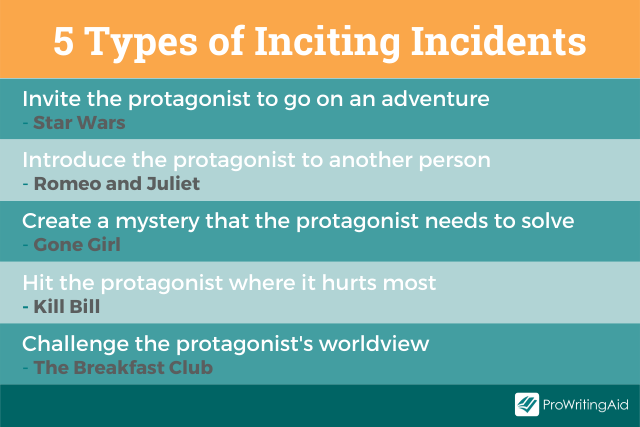
Invite the Protagonist to Go on an Adventure
In many stories, the inciting incident is when the main character gets invited to join a mission, quest, or tournament. This is especially common in the genres of action/adventure, fantasy, and sci-fi.
Sometimes this takes the form of a literal invitation, like a letter in the mail. Other times, it takes the form of some event that forces the protagonist to decide whether they want to accept the call of adventure or to stay in the safety of their normal life.
Examples:
Harry Potter and the Sorcerer’s Stone by J.K. Rowling
The inciting incident is when Hagrid comes knocking on the door and tells Harry he’s a wizard. This is the event that causes to go to Hogwarts and learn to be a wizard, which makes the rest of the plot possible.
The inciting incident is when Luke Skywalker stumbles upon the message Leia left that says “Help me, Obi-Wan Kenobi. You’re my only hope.” This event is the reason why Luke goes to Alderaan and learns to be a Jedi, instead of peacefully growing old on his family’s farm.
The Hunger Games by Suzanne Collins
The inciting incident is when Katniss’s younger sister gets chosen to compete in the Hunger Games. Katniss must then decide whether to let her sister compete and risk watching her die, or to volunteer to take her place in the tournament and risk her own life instead.
Introduce the Protagonist to a New Person
Sometimes, the inciting incident introduces the main character to another person who changes their lives.
This is very common in love stories, where the inciting incidents are usually the “meet-cutes,” when the protagonist meets their love interest.
Examples:
Romeo and Juliet by William Shakespeare
The inciting incident is when Romeo meets Juliet at the masked ball and they fall in love at first sight. They decide to pursue each other, because they haven’t realized yet that their families are sworn enemies.
Pride and Prejudice by Jane Austen
The inciting incident is when an eligible bachelor named Mr. Bingley comes to town. This causes the Bennet sisters to begin the courtship process in the hopes of improving their family’s status.
The Fault in Our Stars by John Green
The inciting incident is when Hazel-Grace goes to a cancer support group and meets Augustus for the first time. This forces her to decide whether to open herself up to the possibility of friendship, or to continue living a mostly reclusive life, as she was doing before.
Create a Mystery That the Protagonist Needs to Solve
In stories with an important mystery plotline, the inciting incident is usually the mysterious event that the protagonist will need to solve.
In a murder mystery, for example, the inciting incident is typically the murder itself.
This is the event that sets off everything to come: the detective searching for clues, the murderer trying to cover their tracks, and maybe even more murders down the line to get rid of loose ends.
Examples:
Murder on the Orient Express by Agatha Christie
The inciting incident is when a wealthy businessman offers Hercule Poirot a large sum of money to protect him, and then gets murdered that same night. This forces Poirot to decide whether to try to solve the murder or to continue enjoying his ride back to England.
Misery by Stephen King
The inciting incident is when the narrator gets kidnapped by one of his fans. The book opens on him waking up in the house of his kidnapper, unable to remember how he got there, so we don’t find out what the inciting incident was until later in the story.
Gone Girl by Gillian Flynn
The inciting incident is when Amy goes missing. This causes the police to start investigating, and her husband to start trying to protect himself.
Hit the Protagonist Where It Hurts Most
Many protagonists have a character arc that centers around seeking revenge. And in a revenge story, the inciting incident is typically—you guessed it—the event that needs to be avenged.
Examples:
The Count of Monte Cristo by Alexandre Dumas
The inciting incident is when Edmond Dantes gets accused of a crime he didn’t commit. The judge sentences Dantes to a harsh imprisonment, without which the rest of the story would never happen.
The inciting incident is when Bruce Wayne’s parents get murdered and he realizes how unjust the world is. The rest of his character arc throughout the Batman movies focuses on Bruce confronting his fear and fighting for justice.
The inciting incident is when Bill attempts to murder the Bride on her wedding day. After she recovers from her injuries, she spends the rest of the movie tracking him down to try to take revenge.
Challenge the Protagonist’s Worldview
In many stories, the inciting incident is an event that challenges the protagonist’s worldview and upsets their normal life.
This is especially common in coming-of-age stories or stories about a protagonist learning an important lesson about the world.
Examples:
To Kill a Mockingbird by Harper Lee
The inciting incident is when Scout learns that her father is defending a Black man and that the town disapproves of his choice. This causes her to start thinking about the town’s prejudices, which will be one of the core themes of the overall novel.
The inciting incident is when a teenage Juno finds out she’s pregnant. After this discovery, Juno must start growing up and taking responsibility for not just her own life but the life of her unborn child.
The inciting incident is when all five of the protagonists get sent to detention together. Spending time with such different types of people shakes up their misconceptions and causes them to learn lessons about themselves and about each other.
These are five types of inciting incidents that are extremely common, but this is not an exhaustive list. There are many other types of inciting incidents out there.
It’s a useful exercise to pay attention to the inciting incident when you’re watching a new movie or reading a new book.
See if the story falls into one of these categories, or if it does something else entirely.
If you’ve already written your inciting incident, but it doesn’t feel quite right, run your opening chapters through ProWritingAid’s Pacing Report.
It’ll highlight the slower-paced sections of your manuscript so you can make sure you’re balancing introspection and exposition with action and dialogue.
If the beginning of your novel is slower paced—and failing to get readers invested—you may need to move your action-based inciting incident forward to hook your reader in.
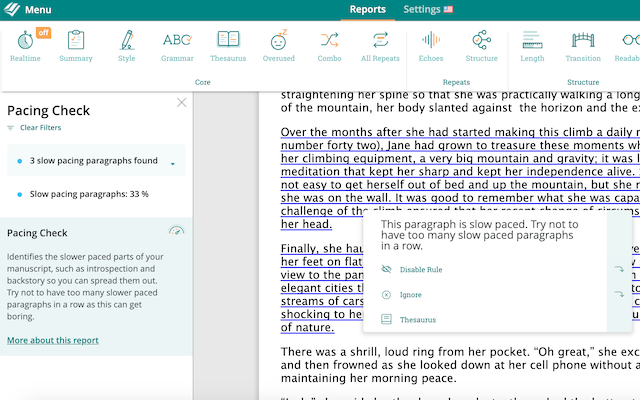
Try the Pacing Report with a free ProWritingAid account.
How Do You Decide When in the Story the Inciting Incident Occurs?
You have three options for when to put the inciting incident: in the first few pages (around 1% into your story), a few chapters in (around 10% into your story), or before the story begins.
Let’s look at each of these options in detail so you can decide which one is right for your story.
Option 1: Lead with the Inciting Incident
You can put your inciting incident at the very beginning of your story—on the first page, maybe even in the first paragraph.
If you choose this option, you’ll put your exposition afterwards. This is great for books that don’t need a lot of setup, or books where the setup might be too boring to hold the reader’s attention for long.
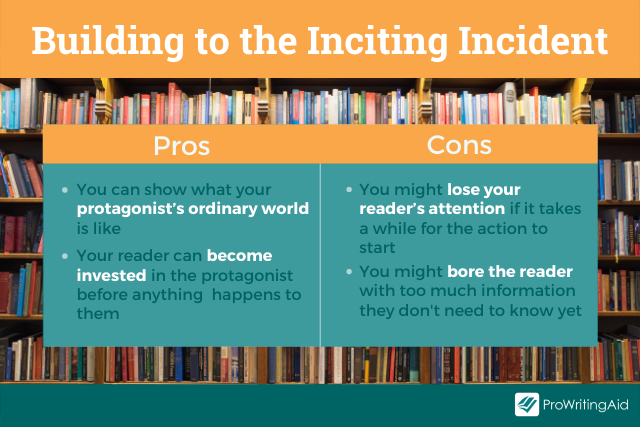
Examples of books with inciting incidents on the first page include:
- The Fault in Our Stars by John Green: The first page begins with Hazel-Grace going to the weekly support group for the first time, and she meets Augustus later in the first chapter.
- Pride and Prejudice by Jane Austen: The first page begins with Mr. Bingley’s arrival in town. The novel famously opens with the line: “It is a truth universally acknowledged, that a single man in possession of a good fortune, must be in want of a wife.”
Option 2: Build Up to the Inciting Incident
You can also put your inciting incident a few chapters into your story, up to around the 10% mark.
In this case, you’ll be able to introduce the reader to the protagonist and show them what the ordinary world looks like before you change things up.
This is great for books that need to do a lot of worldbuilding before the plot begins.
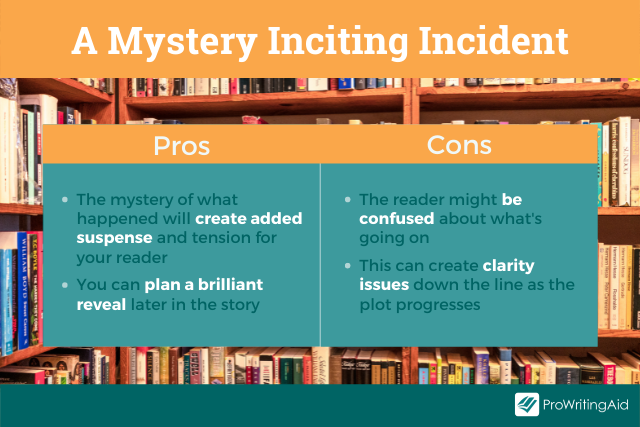
Examples of books that build up to the inciting incident include:
- Harry Potter and the Sorcerer’s Stone by J.K. Rowling: Hagrid finds Harry and tells him he’s a wizard in Chapter 4.
- The Hunger Games by Suzanne Collins: Prim’s name gets drawn for the Hunger Games at the end of Chapter 2.
Option 3: Leave the Inciting Incident a Mystery
If your inciting incident occurs before the story begins, you can reveal that it happened later. This is the rarest option of the three, and requires the most experience to pull off successfully.
This strategy tends to be most common in the mystery and thriller genres.
In murder mysteries, for example, the book often begins after the murder has already been committed, and the rest of the story is about figuring out how the inciting incident happened.
Sometimes the narrator knows the inciting incident but is keeping it hidden from the reader. Other times, it’s a surprise to them both.
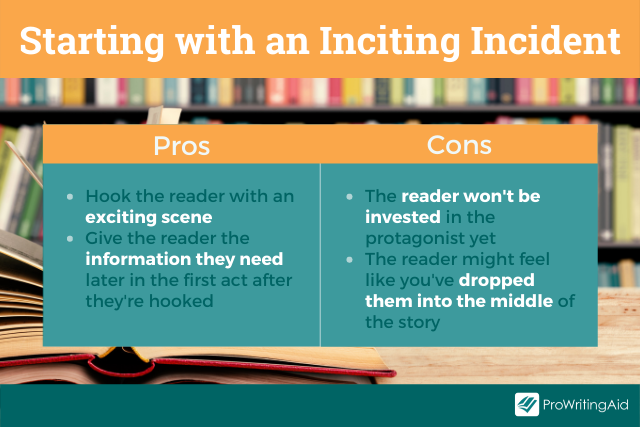
Examples of books with inciting incidents before the story begins include:
- Misery by Stephen King: Paul was kidnapped before the story began, but he doesn’t remember what happened, and he gets told a different story. We slowly figure out the truth as Paul figures it out too.
- The Astonishing Color of After by Emily X.R. Pan: Leigh’s mother committed suicide before the story began. Leigh knows about the suicide, but she doesn’t tell the reader right away. Instead, we slowly find out what happened through flashbacks and conversations.
To figure out where to put the inciting incident in your own story, ask yourself:
- How much setup does your book need at the beginning? For example, do you need to explain detailed worldbuilding, a complicated backstory, or other information to the reader before the story gets going?
- How interesting is the inciting incident? Would it make a good hook to keep the reader engaged?
- Is there any reason to keep the inciting incident a secret from the reader? Would that build tension and suspense?
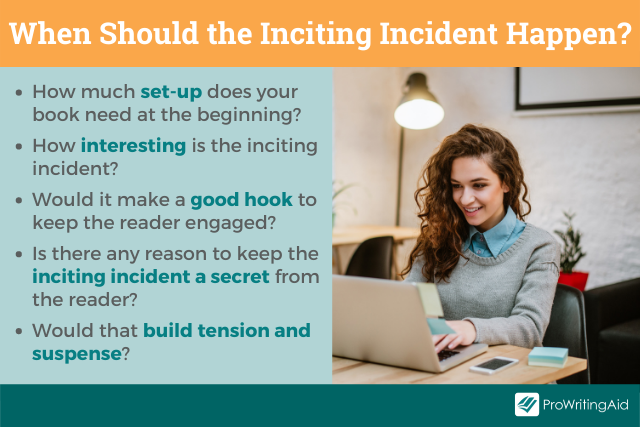
How Do You Choose What Your Inciting Incident Should Be?
Inciting incidents don’t have to be huge, epic moments. They just have to be able to push your protagonist outside their comfort zone and force them to face a new conflict.
It can be as dramatic as the murder of a loved one, or as simple as a letter in the mail.
Just make sure the inciting incident is significant enough to set off a chain of events can snowball into something bigger.
The most important thing is that the inciting incident should matter to your protagonist on a personal level.
You have to understand their comfort zone, in order to understand how best to push them out of it.
If the protagonist loves something or someone, the inciting incident can be an event that puts that person or thing in danger.
If the protagonist has a specific prejudice or misbelief, the inciting incident can be an event that forces them to consider that they might be wrong.
Ask yourself:
- How does this event push the protagonist out of their comfort zone?
- What is the choice the protagonist will face after the inciting incident?
- How will this choice set off the chain of events for the rest of the story?
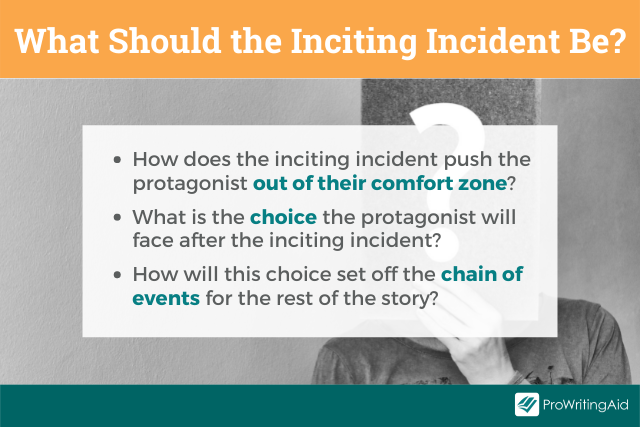
What’s the inciting incident in your favorite book or movie? Let us know in the comments.


